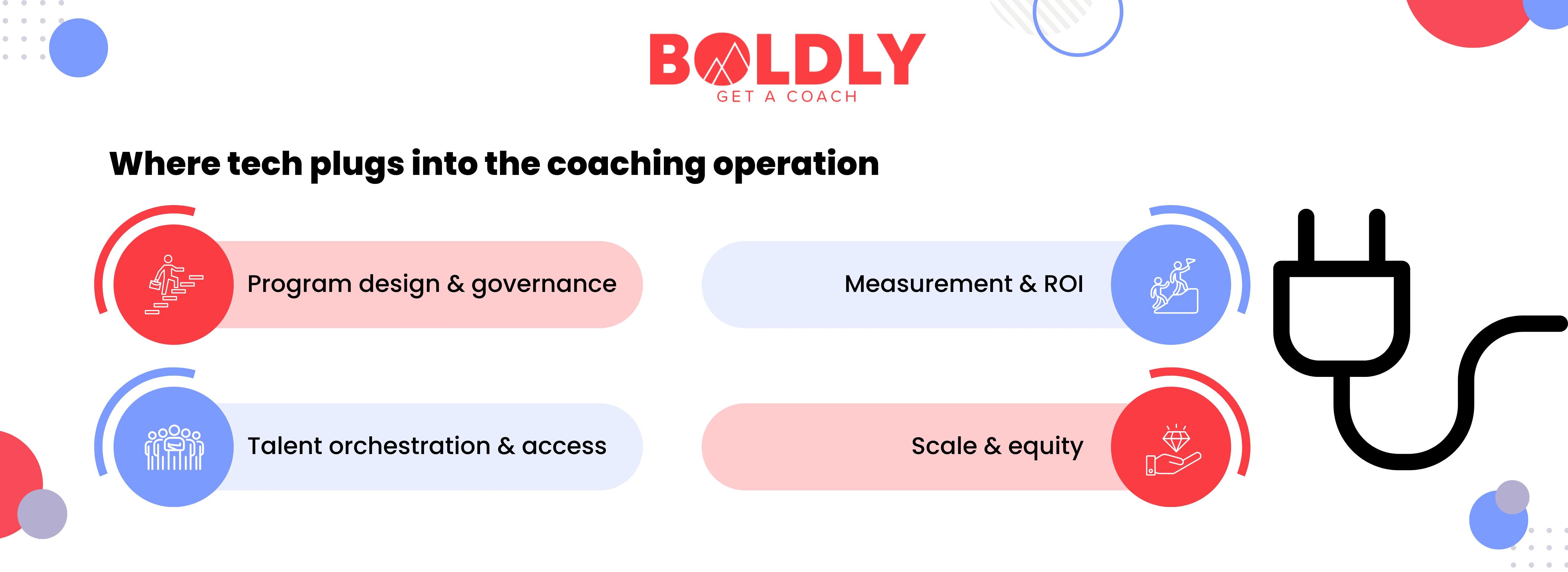Augmented Coaching: Where High-Touch Meets High-Tech
Posted by Alisa Sukdhoe
(and Why HR Should Design for Both)
TL;DR: Don’t choose between AI coaching and live coaching. The real performance lift comes from augmenting great coaches with intelligent tools—so employees get precision, continuity, and momentum while HR gets scalability, measurement, and operational control. That requires a different operating model, not just another platform.
What is “augmented coaching”?
Augmented coaching blends a human coach (for sense-making, empathy, accountability) with a tech layer (for personalization, on-demand practice, nudges, and measurement). Think of the coach as the catalyst for insight and behavior change, and the platform as the always-on system that reinforces, tracks, and scales it. Research on AI-enabled leadership and “AI-augmented” ways of working points to complementary strengths—human judgment and relationships paired with machine-driven personalization and cadence. Harvard Business Review+1
Why HR should care now
The coaching market isn’t just expanding—it’s evolving. HR leaders today face mounting pressure to deliver leadership capability at scale, prove ROI on talent investments, and ensure development programs keep pace with digital transformation. Traditional coaching alone can feel too narrow, while tech-only solutions risk being impersonal and shallow. That’s why the real opportunity lies in augmented coaching, where human coaches and digital platforms work together to create both impact and efficiency.
Demand is up and budgets need proof.
The ICF’s 2023 Global Coaching Study shows the profession’s continued growth worldwide—HR leaders aren’t asking if to coach; they’re asking how to scale it and show impact. ICF
Capability building is going blended.
Leading companies that pair digital tools with coaching and practice communities are reporting faster skill adoption and business impact (e.g., large-scale upskilling programs that combine digital coursework, peer work, and coaching). McKinsey & Company+1
Recognising this shift matters because it changes the way organisations think about coaching—not as a boutique intervention, but as a scalable driver of culture and performance. When HR leaders embrace augmented coaching, they unlock new possibilities for learners: more personalised support, more continuity between sessions, and more measurable impact for the business. Next, let’s explore what this means for the individual coachee—and how their development journey improves when high-tech and high-touch come together.
Benefits of augmented coaching for the coachee
- Precision & relevance: AI surfaces targeted exercises, reflection prompts, and resources personalized to role, goals, and moments that matter—so sessions start deeper and move faster. Harvard Business Impact
- Continuity between sessions: Micro-nudges, journaling, and “in-the-flow” check-ins keep momentum alive when the coach isn’t in the room. Harvard Business Review
- On-demand support: Employees can practice conversations, rehearse presentations, or stress-test decisions with guided digital tools before taking them to their coach for refinement. Harvard Business Review
- Visible progress: Dashboards translate behavior change into trackable outcomes (e.g., confidence, influence, stress management), building motivation and accountability. (Yes, vendors report strong ROI; treat these as directional and triangulate with your own KPIs.) BetterUp+1
How the learning journey changes (and improves)
The Old Coaching Model: monthly sessions + ad-hoc homework
The New Augmented Model:
- Match & baseline: Digital intake, strengths and goal discovery → coach reviews → alignment session.
- Sprint cycles: Short, 2–4 week sprints with one live session plus platform-led micro-actions, reflections, and practice.
- In-the-flow reinforcement: Nudges tied to calendar events (e.g., “big stakeholder meeting Friday? run the difficult-conversation drill now”)
- Measurement loops: Pulse checks, 180/360 snapshots, manager check-ins, and business-aligned KPIs rolled up for HR.
This is how organisations are building durable capabilities at scale—blending live touchpoints with digital reinforcement and analytics. McKinsey & Company+1
Operating model: what to automate vs. what to keep human
For augmented coaching to deliver its full value, HR leaders need clarity on where technology adds speed and scale, and where human coaches must remain at the centre of the experience. Not every part of a coaching program benefits equally from automation. High-volume, repeatable tasks are ripe for digital enablement, while complex, relational, or values-driven moments still demand the insight and empathy of a live coach. Getting this balance right is what separates organisations that simply add a platform from those that truly transform their coaching operations.
Automate (high-volume, rules-based, or data-heavy)
- Intake & triage: goal capture, psychometrics, role data, and needs analysis.
- Matching & logistics: automated coach matching within constraints (time zone, expertise, DEI preferences), scheduling, reminders, rescheduling, and SLA monitoring.
- Micro-reinforcement: nudges, micro-lessons, scenario practice, and spaced-repetition prompts anchored to goals and calendar events.
- Measurement & reporting: auto-collection of pulse data, usage, goal progress, and business-aligned outcomes (with privacy controls). Gartner
Keep human (high-judgment, relational, or contextual)
- Goal contracting & re-contracting: aligning ambition, scope, and sponsorship.
- Sense-making & challenge: navigating ambiguity, emotions, politics, and values.
- Live practice & feedback: role-plays, difficult conversations, leadership presence.
- Ethical guardrails: confidentiality, psychological safety, and escalation paths.
By drawing clear lines between what should be automated and what must remain human, companies set the foundation for operational excellence. This clarity not only reduces cost and complexity but also ensures that coaches spend their energy where it matters most—deepening insight, building trust, and shifting behaviour. With these guardrails in place, the next step is to consider how the coaching function itself should be operationalised when high-tech and high-touch come together.
Where tech plugs into the coaching operation
- Program design & governance
- Define tiers (e.g., exec, manager, emerging leaders) and eligible modalities (1:1, group, on-demand micro-coaching).
- Configure data contract: what HR sees (aggregates), what managers see (opt-in), and what remains confidential. Gartner
- Talent orchestration & access
- Auto-enroll cohorts off trigger events (promotion, new manager, P0 projects) with pre-mapped learning paths and coach pools.
- Measurement & ROI
- Instrument outcomes at three layers: learning (skill signals), behavior (manager/peer feedback), business (e.g., quota, cycle time, retention).
- Use platform dashboards as inputs, not proof alone; vendors report 3–7x ROI, but your TEI comes from linking to your KPIs. CoachHub+1
- Scale & equity
- Offer always-on micro-coaching so more people benefit, while reserving live coaching for moments of greatest leverage—this is how organisations democratize development without diluting quality. JOSH BERSIN
What parts of the coachee journey benefit most from tech?
- Before sessions: discover goals, gather 180°/360° snapshots, surface strengths/opportunities; coach enters with a sharper brief. McKinsey & Company
- Between sessions: nudges, reflection prompts, scenario simulators, and micro-lessons tied to real meetings and deadlines. Harvard Business Review
- After programs: longitudinal follow-ups, alumni communities, and refresher sprints to prevent skill decay and keep leaders “AI-augmented.” Harvard Business Impact
Risk & governance notes (so HR sleeps at night)
As organisations lean into augmented coaching, the promise of scale and efficiency can’t overshadow the responsibility to keep coaching safe, ethical, and effective. HR leaders need to anticipate not only the upside of blending technology and coaching, but also the risks around data privacy, algorithmic bias, and maintaining professional coaching standards. By establishing clear governance practices, companies can protect both their employees and their investment, ensuring that augmented coaching is experienced as trustworthy, fair, and high-quality.
- Data ethics and privacy: codify what’s anonymous/aggregated vs. identifiable.
- Bias management: audit matching algorithms and content recommendations.
- Coach quality: require accredited coaches and ongoing supervision; use platform data to inform—not replace—professional judgment. (ICF’s standards remain a strong anchor as the market scales.) ICF
Strong governance does more than keep risk at bay—it builds confidence among leaders, participants, and stakeholders that the program is sustainable and ethical. With these safeguards in place, organisations are in a position to measure outcomes credibly and communicate value with confidence. The next step is to explore the proof-points and ROI evidence that show why augmented coaching isn’t just a good idea in principle, but a proven strategy for capability building and business impact.
A quick proof-point roundup you can share with finance
- Companies blending digital + coaching report faster capability building and measurable impact when programs include peer work, coaching, and digital practice. McKinsey & Company
- HR and business literature emphasizes augmented leadership—humans and AI working in tandem—not substitution. Harvard Business Review+1
- Vendors report strong ROI and adoption when AI extends access and measurement; validate with your data model and a 90-day pilot. BetterUp+2Inc.com+2
Call to action: Don’t pick sides—design the blend
If you’re doubling down on only live coaching, you’ll struggle to scale and measure. If you’re betting only on AI coaching, you risk shallow change and low stickiness for your most critical leaders. The win is augmented coaching—high-tech plus high-touch—underpinned by operational excellence.
Start with a 90-day pilot:
- Pick one population (e.g., new managers) and a business-critical outcome.
- Stand up a blended journey (live coach + digital reinforcement + manager touchpoints).
- Instrument three metrics (learning, behavior, business) and pre-commit to a scale/stop decision based on the data.
Reach out to us for a copy of our Augmented Coaching Pilot Blueprint.
If you're interested in learning more about how BOLDLY can help your organisation, we invite you to explore our or contact us here.







